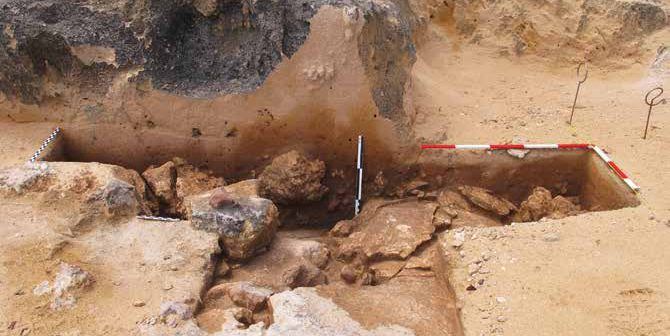Page 7651
Jan 30, 2020
How Mini Sabbaths Will Save Your Brain
Posted by Genevieve Klien in categories: computing, health, neuroscience
Have humans become an indoor species? Given that Americans spend, on average, 93 percent of their time indoors, it would seem that we are indeed suffering from what some call “nature deficit disorder.”
We don’t need a fancy term to realize we might benefit from spending more time outdoors. Getting out for a gentle walk or a vigorous hike is likely to reduce stress, improve health, and increase emotional well-being.
If you spend much time on a computer, you probably reach a time in the day when you have so many browser tabs and programs open that your computer slows considerably. It’s time for a reset.
Jan 30, 2020
Stress test reveals graphene won’t crack under pressure
Posted by Genevieve Klien in categories: engineering, materials
Graphene is a paradox. It is the thinnest material known to science, yet also one of the strongest. Now, research from University of Toronto Engineering shows that graphene is also highly resistant to fatigue—able to withstand more than a billion cycles of high stress before it breaks.
Jan 30, 2020
CDC confirms first human-to-human transmission of coronavirus in US
Posted by Genevieve Klien in categories: biotech/medical, health
“This is a very serious public health situation,” said Dr. Nancy Messonnier, director of the National Center for Immunization and Respiratory Diseases. “Moving forward, we can expect to see more cases, and more cases means more potential for person-to-person spread.”
The virus, which emerged Dec. 31, has already spread to more people than the 2003 SARS epidemic, which sickened roughly 8,100 people across the globe over nine months. The transmission makes the U.S. at least the fifth country where the infection is now spreading through human-to-human contact, including China. Officials of the Centers for Disease Control and Prevention said there are at least nine cases of human-to-human transmission outside of China, as of Thursday.
As of Thursday afternoon, 8,137 cases were confirmed in mainland China alone, according to Chinese state media, and more than 100 cases were confirmed elsewhere around the world — bringing the global total to at least 8,248.
Jan 30, 2020
DARPA’s call for robot drone ships Reports
Posted by Genevieve Klien in categories: drones, robotics/AI
The Defense Advanced Research Project Agency has set its sights on a new kind of drone ship — one that doesn’t contemplate a human ever setting foot on it. Dubbed NOMARS (No Manning Required, Ship), the new ships could feature radical new designs and cut costs by removing any elements normally needed to accommodate people.
Jan 30, 2020
LifeXtenShow – Will Life Extension Kill the Pension System?
Posted by Paul Battista in category: life extension

Giuliano uses this LE 101 episode of LifeXtenShow to explain what might happen to the pension system if partial, or total, rejuvenation comes to pass – and discusses why such a system was created in the first place.
Jan 30, 2020
Remember the time we bombed Mexico with German rockets?
Posted by Brent Ellman in category: military
Germany spent the end of the 1930s and half the 1940s inventing and perfecting missiles. They made so many, they still had a ton of them left over after the end of World War II. So of course, the leftover weapons were confiscated by the United States. And here’s one of the things we did with them.
Anyone who knows the details about a V-2 rocket has to wonder how any nation managed to make so many of them. The V-2 ran on alcohol and liquid oxygen, only one of which was easy to get. It was a giant behemoth, standing forty-six feet high and weighing fifty-six thousand pounds. It moved through the air at 3,500 miles per hour. Production started on these models in the mid-1930s, but the first one wasn’t actually launched as a military weapon until September 1944, when the Germans bombed London with it.
Jan 30, 2020
These solar-powered barges can scoop up 50 tons of plastic from rivers each day
Posted by Omuterema Akhahenda in categories: robotics/AI, sustainability
While removing the plastic waste that currently contaminates the ocean today will be crucial for protecting marine ecosystems, it is arguably more important that we stop any more plastic trash from entering the ocean. Fortunately for humanity, The Ocean Cleanup, a nonprofit taking on plastic waste in the ocean today, also has a novel solution for stopping plastic from entering it via rivers.
The solution comes in the form of a solar-powered barge named the “Interceptor”. The 24-meter-long (78 feet) vessel resembles a large houseboat and uses a curved barrier to catch waste floating downstream. The trash, much of it plastic, is directed to the “mouth” of the barge — which operates autonomously and silently — from where it rolls up a conveyor belt and is dropped into dumpsters. Apparently, the Interceptor is capable of collecting up to 50 tons of waste a day.
Currently the Klang River in Malaysia is home to one of these Interceptors where it can be seen quietly scooping up trash. The Klang river alone sends more than 15,000 tons annually into the sea, making it one of the 50 most-polluting rivers across the globe. As well as the barge in Malaysia, one has been stationed in Jakarta, the overcrowded capital of neighboring Indonesia, while two others will be sent to Vietnam and the Dominican Republic.
Jan 30, 2020
Archaeology Places Humans in Australia 120,000-Years-Ago
Posted by Prem Vijaywargi in category: futurism
Shell middens and a potential ancient hearth add to growing evidence of a much deeper human occupation period in Australasia (prehistoric Sahul).
A meticulously detailed 11 years research program has concluded that there is compelling evidence for a human presence 120,000 years at Moyjil, Point Richie, on the far south coast of Victoria.
Excavation in basal calcrete at Moyjil containing burnt stones and charcoal. Image credit – Ian J. McNiven.

















